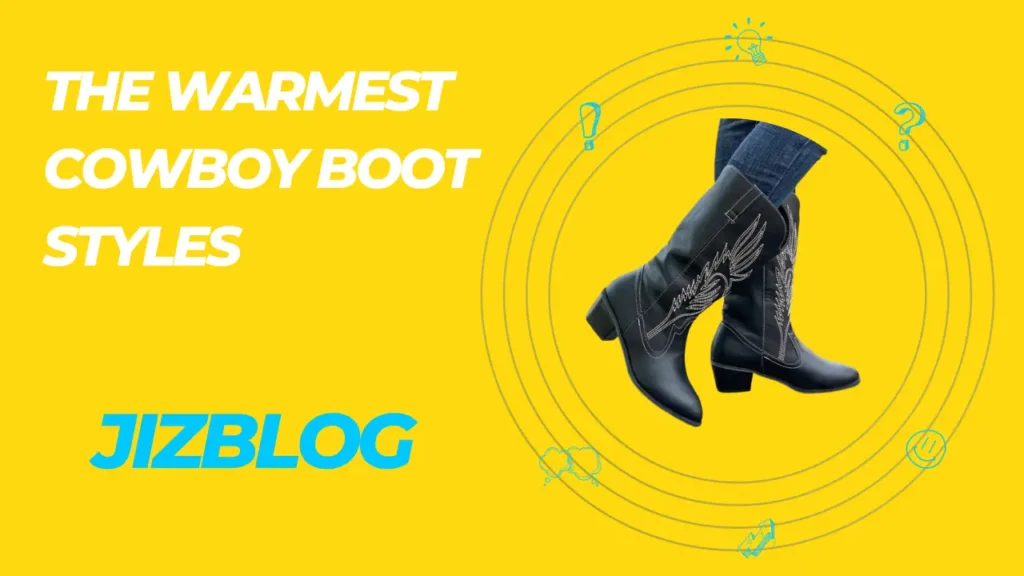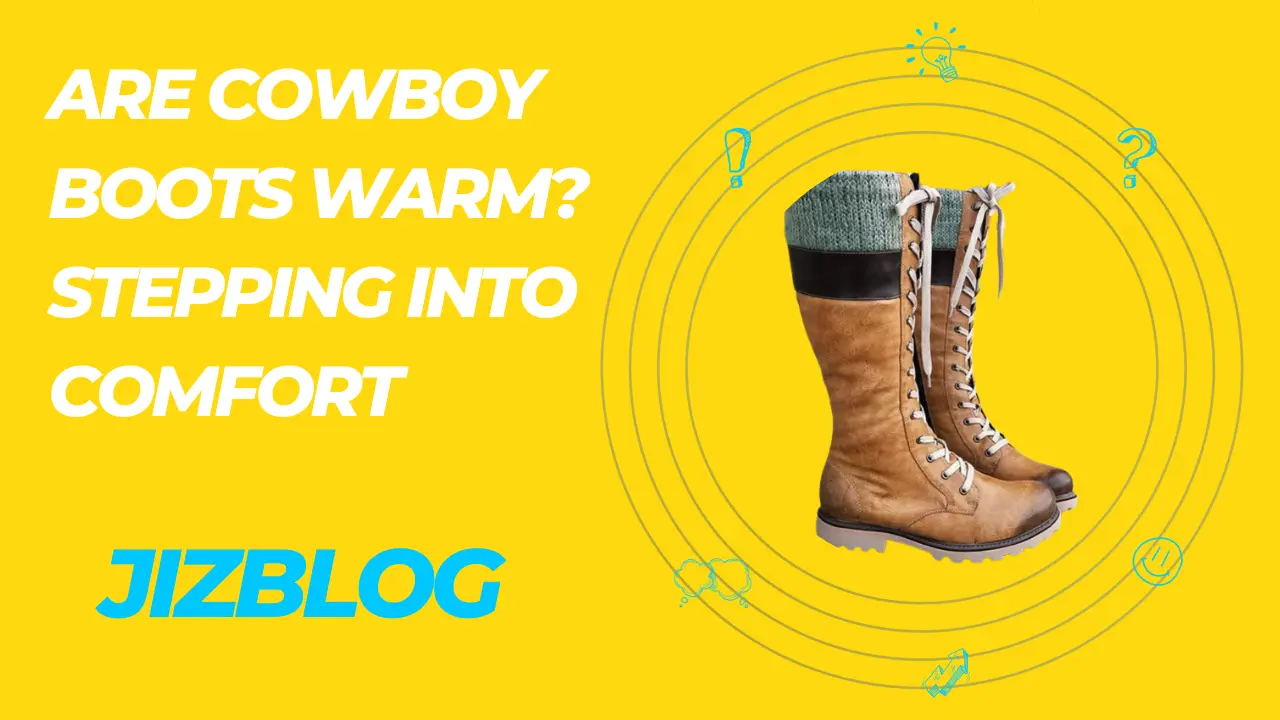Howdy, boot buddies! Ever find yourself pondering are cowboy boots warm? Well, you’re in good company because I’ve had that same thought while navigating chilly days in my favorite Western kicks. Picture this: I once underestimated the winter chill and ended up with chilly toes that felt like they’d wandered into an icy corral. In this post, we’re diving into the warmth factor of cowboy boots, exploring whether these stylish companions can keep your feet cozy in colder weather. So, join me as we uncover the toasty secrets of cowboy boots and make sure your feet stay snug on every Western adventure!
The Structure of Cowboy Boots
Cowboy boots are constructed from strong leather and built to cover and support the foot and ankle. Here are some key elements that help make them warm:
- Shaft height – Cowboy boot shafts rise 8-14 inches up the calf, protecting the vulnerable ankle joint and lower leg from the elements.
- Snug fit – Cowboy boots are designed to fit close to the leg with minimal air gaps that can let in cold air. Many have partial inside zippers but still fit snugly around the calf when zipped.
- Stacked heel – The elevated stacked leather heel keeps the foot slightly tilted, reducing contact with cold ground surfaces. Stacked heels are also sturdy for walking on uneven terrain.
- Pointed toe box – The distinct pointed toe shape leaves extra room for insulating socks or liners while still fitting ergonomically.
- Outsole – Durable rubber or leather outsoles provide traction and protect feet from the cold ground. Some have deep tread lugs for added grip.
Materials Matter
The materials used to construct cowboy boots also affect their warmth. Here are some common ones:
- Full-grain leather – Nearly all cowboy boots have uppers made of full-grain leather, prized for their natural water resistance, durability, and breathability. Thicker leathers like steer hide provide more insulation.
- Shearling – Lining boots in soft sheepskin shearling wicks away moisture and adds warmth. It’s extra cozy but less rugged than leather alone.
- Synthetic linings – Many boots have man-made lining materials that are designed to insulate while wicking moisture. These make boots lighter.
- Synthetic uppers – While less common, some cowboy boots are made with synthetic leather or fabric uppers. These are less breathable than real leather.
Temperature Ratings of Cowboy Boot Insulation Types
| Insulation Type | Temperature Rating |
|---|---|
| Uninsulated leather | Down to 30°F / -1°C |
| 200g insulation | Down to 5°F / -15°C |
| 400g insulation | Down to -4°F / -20°C |
| 600g insulation | Down to -20°F / -29°C |
| 800g insulation | Down to -40°F / -40°C |
| 1000g insulation | Down to -60°F / -51°C |
To Waterproof or Not to Waterproof
Cowboy boots are somewhat water-resistant thanks to their leather construction. But for warmer, drier feet in wet conditions, you can add waterproofing treatments.
Beeswax- or oil-based waterproofers (like mink oil) soak into leather and make it more impervious. These darken leather and need reapplication every few months.
Silicone- or wax-based waterproofing sprays and creams won’t alter leather color. But they wash off easier with wear and may need more frequent application.
Insulation Tricks and Tips

Even genuine leather cowboy boots likely won’t keep you warm enough in harsh winter temps. Here are some easy ways to make them warmer:
- Wear thick wool or alpaca blend socks that wick moisture and provide insulation.
- Combine a thin liner sock with regular socks to prevent blisters and double insulation.
- Use detachable insoles or add insulating insoles like shearling or gel to block cold from the ground.
- Consider wearing gaiters or high boot socks around the calf for a draft barrier.
- Apply beeswax to laces and stitch or tape over them to prevent cold from seeping through small gaps.
- Weatherproof leather with wax- or oil-based treatments to block wind and water.
- Stuff boots with paper or rags when not wearing them to help them hold shape and block moisture.
Waterproofing Effectiveness of Cowboy Boot Treatments
| Treatment | Repels Water | Repels Salt & Chemicals | Crack/Scrape Resistant |
|---|---|---|---|
| Mink oil | Excellent | Poor | Fair |
| Beeswax | Excellent | Fair | Good |
| Silicone spray | Good | Excellent | Poor |
| Acrylic spray | Good | Excellent | Poor |
| Wax paste | Excellent | Fair | Excellent |
The Warmest Cowboy Boot Styles

Not all cowboy boots are equal when it comes to keeping feet warm. Here are some of the warmest options to seek out:
Work Boots
Many cowboy-style work boots have features designed for insulation:
- ThinsulateTM or PrimaLoft® synthetic insulation built into linings
- Full-grain or nubuck leather uppers, sometimes with a Gore-Tex® waterproof membrane
- Aggressive lug soles for shock absorption and traction
- Extra ankle support and reinforced toes
- Brands like Ariat, Justin, Wolverine, Timberland, and Red Wing
Hunting Boots
Insulated hunting boots fuse cowboy style with cold-weather performance:
- 800-1000+ gram insulation like ThinsulateTM Ultra or ArcticShield®
- Waterproof, breathable Gore-Tex® membranes or rubber bottoms
- Blaze orange colors for visibility plus camo options
- Lightweight, flexible constructions for all-day wear
- Brands like Irish Setter, Kamik, Ariat, and Rocky
Western Work Boots
Rugged ranch work boots are built to handle long days in harsh conditions:
- Oiled full-grain leather or nubuck uppers
- Fleece, flannel, or shearling linings
- Waterproof membranes like Sympatex®
- Vibram® outsoles with deep lugs for stability in snow
- Tall 16+ inch shafts to protect calves
- Brands like Double H, Ariat, Chippewa, and Justin
Cowboy Snow Boots
Functional cowboy-inspired snow boots offer premium cold-weather insulation:
- Seam-sealed waterproof construction
- 400-800 gram insulation like ThinsulateTM
- Soft synthetic fur linings for comfort and warmth
- Full-coverage weatherproof panels or rubber lowers
- Outdoor traction outsoles
- Brands like Bearpaw, Kamik, UGG, and Sorel
The Bottom Line on Warmth
While leather cowboy boots do provide decent protection in fall and milder winter weather, truly frigid temperatures call for upgraded insulation. Waterproofing treatments can help block wind and moisture penetration. But for the coldest conditions, opt for boots designed specifically for warmth like insulated work or hunting styles. You can enjoy the iconic cowboy style while stomping through the snow with the right boot features and linings.
Conclusion
While uninsulated leather cowboy boots provide reasonable warmth in fall and milder winter weather, truly cold conditions demand boots built for insulation. With weatherproofing treatments and liners, cowboy boots can protect better against wind and cold. But for the iciest temps, specialized styles like insulated work or hunting boots are your best bet. So are cowboy boots warm in subzero cold? With the proper gear they can be, but upgrade the insulation for the coldest weather. At the end of the day, iconic cowboy style and winter warmth need not be mutually exclusive with the right boots and preparation.
FAQ’s
How do you make cowboy boots warmer?
Add thick socks, insulating insoles, waterproofing treatments, or boot liners.
What are the warmest cowboy boots?
Insulated work boots and hunting boots rated for extreme cold.
Do cowboy boots keep feet dry?
Leather resists water but treating them makes cowboy boots more waterproof.
Should you size up on cowboy boots for thick socks?
Yes, go a half or full size up to accommodate insulating sock layers.

